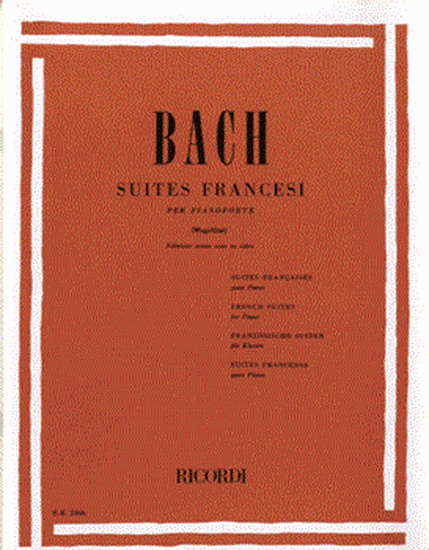Bach, Johann Sebastian : Französische Suiten Nr.1 d-moll BWV 812
Work Overview
Publication Year:1806
First Publisher:Hoffmeister & Kühnel
Instrumentation:Piano Solo
Genre:suite
Total Playing Time:13 min 00 sec
Copyright:Public Domain
Commentary (1)
Author : Asayama, Natsuko
Last Updated: May 1, 2007
[Open]
Author : Asayama, Natsuko
Bach composed six "French Suites." Bach himself titled them "Suites for Keyboard," and the person who coined the name "French Suites" is unknown. It is likely that these suites came to be called so because they are elegant, approachable, and refined music, incorporating a French sensibility. The exact composition date is also unclear, but it is estimated to be around 1722. This is because five of these French Suites (Nos. 1-5) are included in the "Notebook for Anna Magdalena Bach" (1722), a collection of pieces Bach first presented to his second wife, Anna Magdalena, whom he married in 1721 after the death of his first wife.
Each suite consists of several dance movements, typically progressing through an Allemande, Courante, and Sarabande, concluding with a Gigue. These four dance movements constitute the classical standard form of keyboard suites established in the late 17th century. Following the custom of the time, Bach employed typical melodic patterns and idioms from the beginning of each piece, making these dances immediately recognizable.
- Allemande: A French word meaning "German," it is in 4/4 time and begins on an upbeat. It is a dance that proceeds calmly and continuously without interruption.
- Courante: A relatively fast-paced and lively dance. In the French style, it is in 3/2 or 6/4 time, while in the Italian style, it is in 3/4 or 3/8 time.
- Sarabande: A triple-meter dance of Spanish origin, where two consecutive measures form a single unit. It proceeds with solemnity and gravity.
- Gigue: A light and fast dance originating from England. Its original time signatures were typically 3/8, 6/8, or 12/8, but Bach sometimes notated it in 4/4 time, dividing each beat into triplets.
In Bach's time, the standard sequence of dance movements was A-C-S-G (Allemande-Courante-Sarabande-Gigue), but it was permissible to insert various "modern dances" between the Sarabande and the Gigue. Representative examples include the Air, Minuet, Gavotte, and Bourrée.
- Air: Equivalent to the Italian "aria," it is a song-like piece of music. Therefore, an Air is not inherently a dance but an instrumental piece often inserted into suites composed of dances.
- Minuet: A graceful and dignified dance that originated in France and became popular among the upper classes. It is in a calm 3/4 time and was later adopted by Haydn in his symphonies. Typically, it appears to be in two parts, and with repetitions, it takes the form of Minuet-Trio-Minuet da capo. (The middle section is called "Trio" because, in court dances, an obligato instrument was used in the middle section to create a trio ensemble, adding variety to the sound. In keyboard suites, it is not necessarily written for three voices.)
- Gavotte: Another bright and lively dance that originated in France and became popular among the upper classes. It is usually in 4/4 time and begins on the third beat.
- Bourrée: Appearing in Suite No. 5, it is a light, duple-meter dance of French origin, particularly favored for dancing in court.
Of the six French Suites, the first three are in minor keys, and the latter three are in major keys, with each suite maintaining tonal unity.
French Suite No. 1 in D minor, BW 812
In the first suite, clear connections can be observed in the main melodies of the Allemande, Courante, and Gigue. Although the Minuet is divided into two parts, the second part is extensive and does not conform to the standard trio form. The Gigue is unusually in a complete 4/4 time, which makes the dotted rhythms stand out even more sharply. While not a strict fugue, it is a three-voice sinfonia based on imitation. In the latter half, an inversion of the opening theme is added.
Movements (5)
PTNA & Partner Channel Videos(19items) View More
- favorite_border
- 1
Recording Date: 1997/12/6
Recording Location: 飯盛野教会(ライブ録音) ピアノ:ブリュートナーNo.4
- favorite_border
- 0
Recording Date: 1997/12/6
Recording Location: 飯盛野教会(ライブ録音) ピアノ:ブリュートナーNo.4
- favorite_border
- 0
Recording Date: 1997/12/6
Recording Location: 飯盛野教会(ライブ録音) ピアノ:ブリュートナーNo.4
- favorite_border
- 0
Recording Date: 1997/12/6
Recording Location: 飯盛野教会(ライブ録音) ピアノ:ブリュートナーNo.4
- favorite_border
- 0
Recording Date: 1997/12/6
Recording Location: 飯盛野教会(ライブ録音) ピアノ:ブリュートナーNo.4
Sheet MusicView More
Scores List (27)

(株)全音楽譜出版社

(株)全音楽譜出版社

(株)全音楽譜出版社

KMP(ケイ・エム・ピー) ケイエムピー

ハンナ(ショパン)

(株)音楽之友社

(株)音楽之友社

(株)全音楽譜出版社

(株)音楽之友社

ヘンレー

ヘンレー

ヘンレー

ヘンレー

(株)全音楽譜出版社

(株)全音楽譜出版社

ヘンレ社(ヤマハ)

ベーレンライター社

ヘンレ社(ヤマハ)

HAL・LEONARD

(株)新芸術社






















